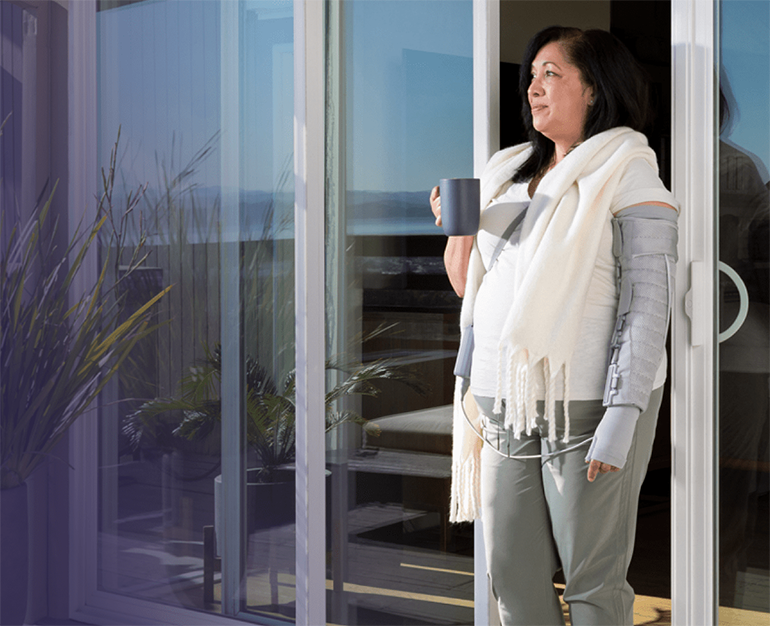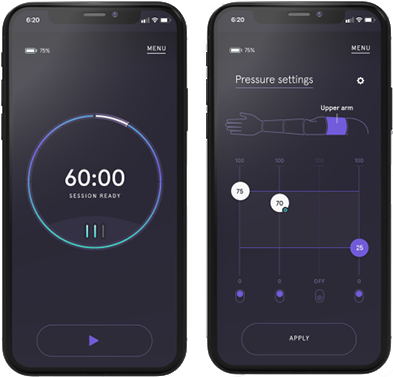
Koya Medical, a medtech company based in California, has developed the Dayspring active compression system for the treatment of lymphedema. The company received FDA clearance for the use of Dayspring on the upper extremities in June 2020, and just recently announced 510(k) clearance for use in the lower extremities.
Lymphedema involves impaired lymphatic drainage resulting in painful swelling, and typically occurs after surgical procedures, such as the removal of cancerous lymph nodes. At present, the condition is treated through manual manipulation of the lymph system by a healthcare professional or using a compression device. Pneumatic compression devices are typically tethered to an electrical outlet, meaning that a patient must remain in place for significant periods of time, and therefore such devices interfere with daily living.
The Dayspring compression system allows patients to move around, and it includes a rechargeable, hand-held control unit, and a breathable mesh that is worn on the affected limb. The system also includes an app that allows patients and clinicians to tailor their treatment and keep track of their progress.
Medgadget had the opportunity to speak with Andy Doraiswamy, CEO, president and founder of Koya Medical about the technology.
Conn Hastings, Medgadget: Please give us an overview of lymphedema and who it affects.

Andy Doraiswamy, Koya Medical: An estimated 20 million Americans live with lymphedema, a chronic, progressive and incurable condition where a buildup of protein rich fluid causes painful swelling in the arm, leg and other regions of the body. The condition occurs when the body’s lymph system is damaged or blocked, often from cancer treatment, surgery, trauma, infection, venous insufficiency or obesity. One in five women who survive breast cancer develop lymphedema.
Lymphedema is severely debilitating both physically and emotionally. People living with lymphedema experience a decrease in quality of life and functional capacity due to the swelling and pain associated with the condition. Left untreated or mismanaged, lymphedema can cause permanent changes to the tissues under the skin, infection, severe physical and functional impairments, significant pain and in some cases may even require limb amputation.
Medgadget: How is the condition currently treated?
Andy Doraiswamy: Lymphedema is treated with manual lymph drainage (MLD) provided by certified lymphedema therapists, along with daily self-administered compression therapy and lifestyle-management strategies like exercise. Applying pressure to the affected limb increases blood flow and reduces pain and swelling. Traditionally, active compression therapy is administered through pneumatic compression devices (PCDs). These devices improve lymphatic flow in a manner similar to MLD, however they plug into a wall thereby restricting patient movement and mobility, and in turn limit adherence.
Medgadget: What inspired you to develop a new treatment for lymphedema?
Andy Doraiswamy: We set out to solve a problem that I identified when my father was being treated for lymphedema after prostate cancer treatment. After beating his cancer, he was still in “patient” mode for a long time because of his lymphedema diagnosis. His treatment sessions required him to put his life on pause and sit still for an hour each day, often away from the family and activities he used to enjoy. I knew there had to be a better option for him and other patients that didn’t require them to put daily life on hold for treatment.

Medgadget: Please give us an overview of Dayspring Therapy and how it works.
Andy Doraiswamy: Dayspring is the first wearable and mobility-enabled compression solution designed with real life in mind. The system includes a low-profile garment made of soft, breathable mesh using Koya’s patented Flexframe™ technology, which allows for movement and mobility during treatment. It comes with a smart, rechargeable, hand-held controller that can be worn on a lanyard and a mobile app that allows clinicians and their patients to personalize treatment options.
Our active garment provides compression levels similar to that of traditional PCD pumps, while enabling movement and mobility during treatment that patients did not have before.

Medgadget: How does the app work, and how does it help to improve patient experiences and outcomes?
Andy Doraiswamy: The Koya app allows users and/or their clinicians to engage with the treatment by programming personalized options, such as pre-treatment clearance. The Koya app also allows you to view therapy history and access advanced treatment settings such as customized pressure ranges. The app and the digital health backend are part of Koya’s overall ambition to support personalized therapy in and out of the clinic to improve compliance and outcomes. In clinical studies, we observed a 98% adherence to therapy. The app is available for both IOS and Android.
Medgadget: Congratulations on receiving FDA clearance for Dayspring use on the lower extremities. How does this differ with the upper extremities in terms of patient experience and device usage? Is a larger device required?
Andy Doraiswamy: Lymphedema in lower extremities represents 80% of lymphedema cases. The Dayspring devices for both the upper and lower extremities are similar. They share the same design philosophy, user interface and the underlying Flexframe technology with the goal of enabling meaningful movement and mobility for patients. Similar to the upper extremity device, the lower extremity system is comprised of a low-profile active garment, a smart controller and the Koya app that allows patients and their clinicians to customize treatment options. The garment element for lower extremities is larger to accommodate for the larger limbs, but it generally operates in the same way enabling movement and mobility.

Link: Koya Medical’s homepage…
